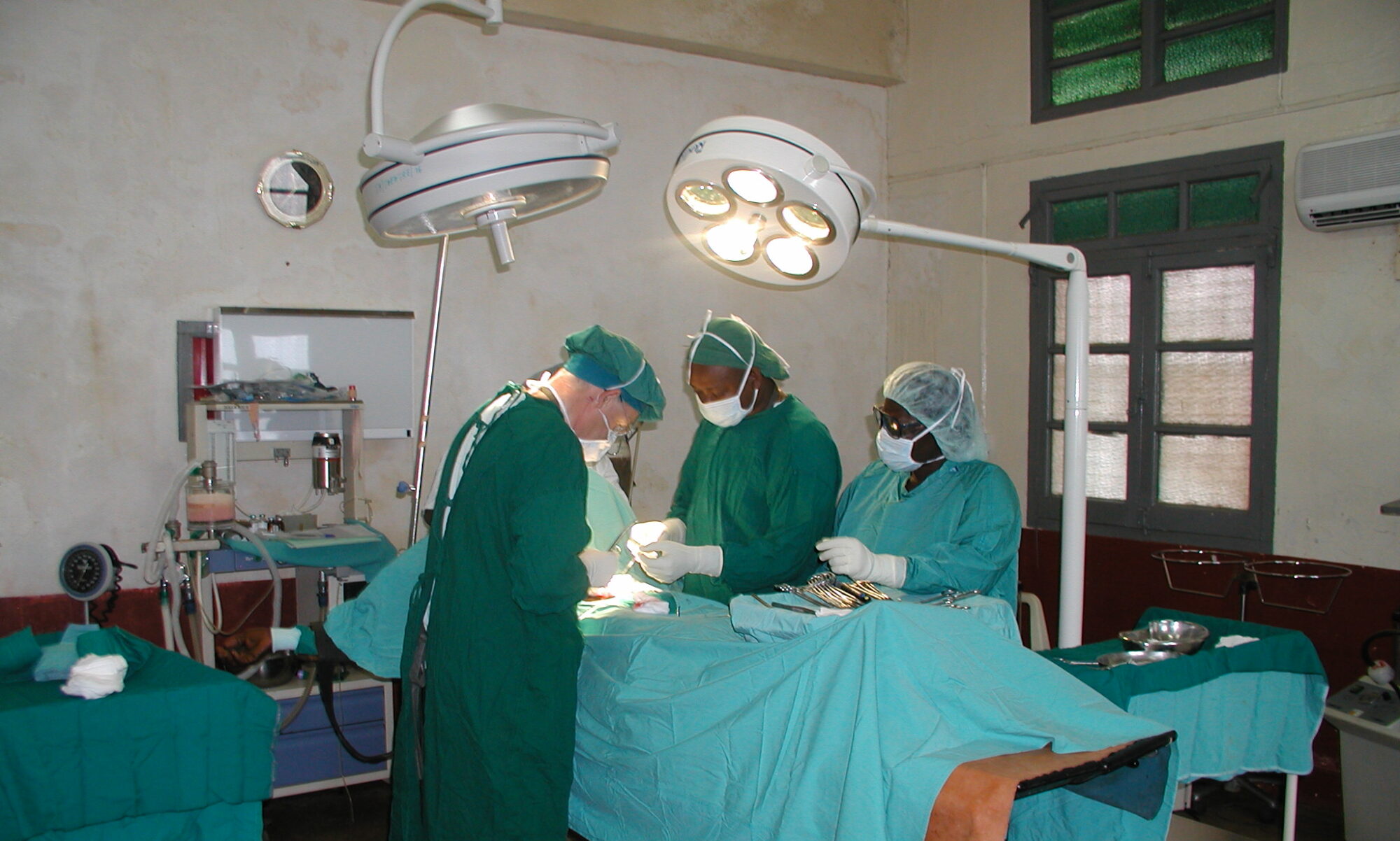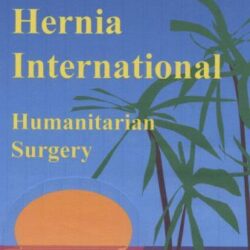Camp: Police Hospital Freetown, Sierra Leone
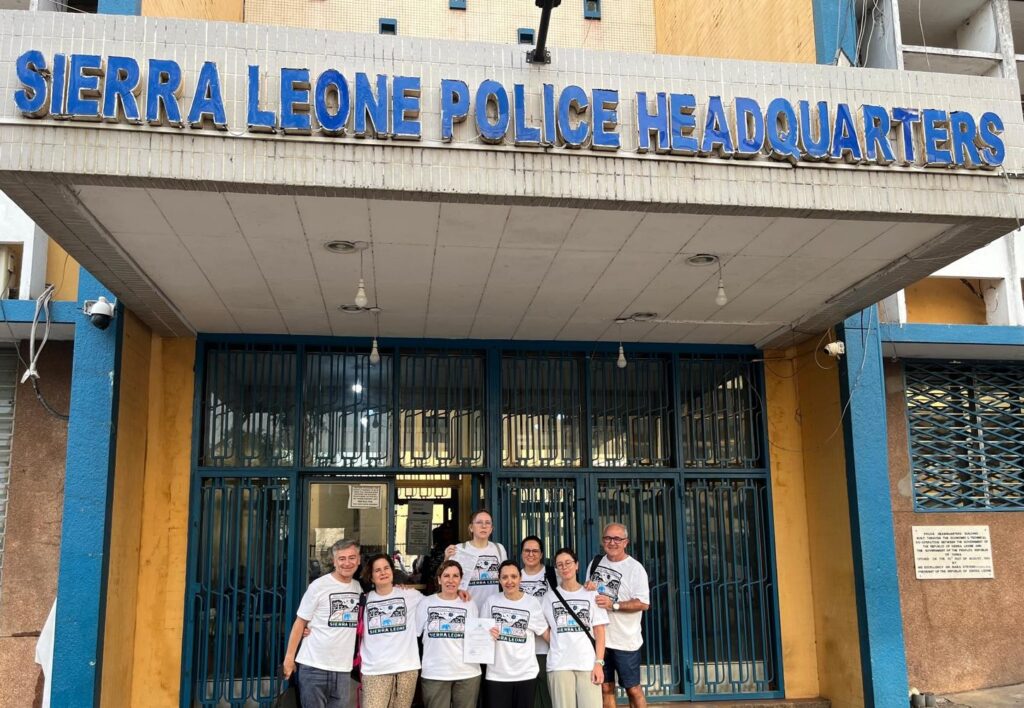
DATE: 27 April – 4 May 2024
1.1 DATES AND LOGISTICS DEPLOYED:
We started the trip on the morning of 27/04. 7 members of the group will leave from Vigo and 1 from Gran Canaria. We have a long journey to our final destination, the Police Hospital in Freetown, Sierra Leone. We meet in Madrid, where David and Nuria are waiting for us to deliver the diathermy generator that we have to take with us. In the end we check in 11 bags of between 20 and 23Kg of material. We fly with Royal Air Maroc, with a stopover in Casablanca.
We bought the plane tickets through Angelis, an agent of Halcon viajes.
To enter the country you need a Visa, which can be easily obtained online via the link on the Spanish foreign ministry’s website. It costs $85 and takes a few days to be issued

1.2 ADULT PATIENTS:
As a ventilator was not yet available, only pathologies that were amenable to spinal anaesthesia and local anaesthesia and sedation were performed.
Surgery was mainly performed on abdominal wall pathology, hydroceles and large lipomas.
1.3 PAEDIATRIC PATIENTS:
No paediatric patients were operated on in this campaign, as general anaesthesia cannot be performed.
1.4 Total procedures
152 procedures
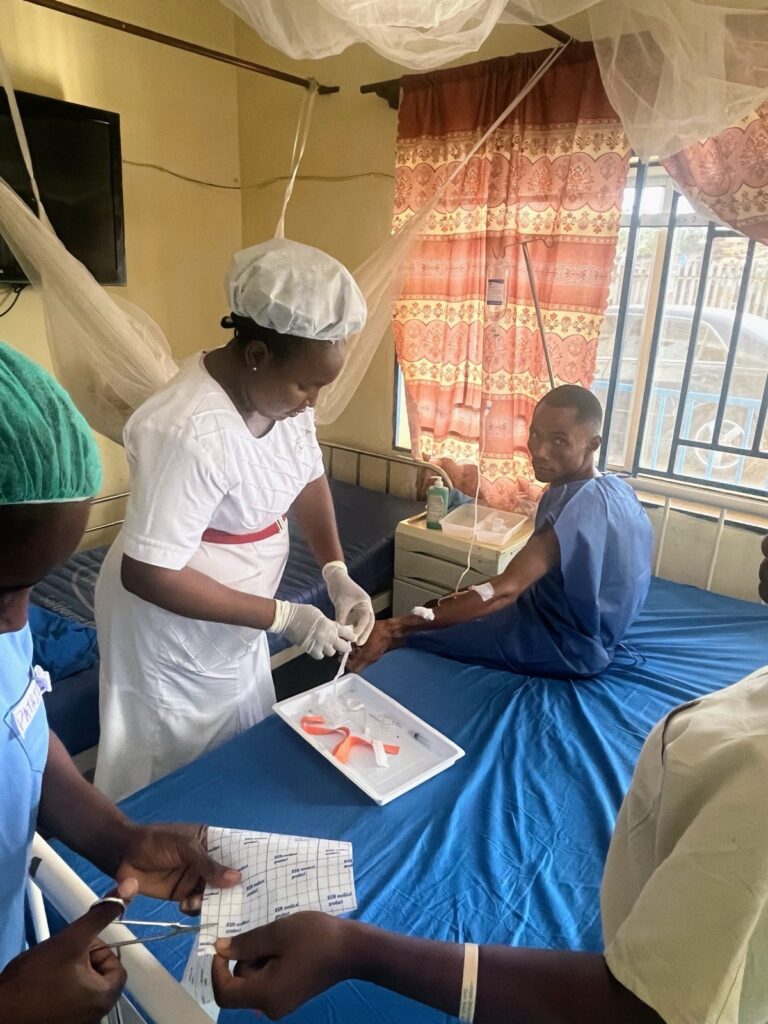
Inguinal hernia: 91, all repaired with Lichtenstein technique
Epigastric hernia: 8
Umbilical Hernia 3
Femoral Hernia 2
Hydrocele: 20
Testicular tumour: 2
Lipomas: 19
Mandibular tumour: 2
Sebaceus cyst: 1
Oral mucosal lesion: 1
Urgent reviews: 3
1.5 Total patients

1.6 COMPLICATIONS:
As complications, 3 patients required immediate postoperative reoperation: 2 haematomas in giant inguinoscrotal hernias and 1 seroma of 1 giant sebaceous cyst on the scalp. All complications resolved without further incident. To date, one month after our return, we have not been informed of any incident.
2. CAMPAIGN REPORT
2.1. THE PLACE
The hospital has 2 operating theatres, including a sterilisation room. The surgical material available is sufficient for hernias and other simple pathologies, but there is no material for laparotomy, thyroid surgery or surgery on children.
There is air conditioning in the operating theatres, which is to be welcomed, although due to the constant power cuts, it does not cool as much as we would like.
They have an autoclave for sterilisation, which they hardly use, because they find it too slow. They use pressure cookers, which worked correctly, except for one day, when we were stopped for 3 hours due to a problem with the closure of the cooker, which was finally solved.
It has 2 diathermy generators that work correctly, but only one of them can be used, because the other one does not have a grounding plate (it is an old, metallic plate). We used the generator we took with us and the other one, which worked properly for 4 days. Then the connection to the plate broke and they couldn’t fix it, so we spent 1.5 days with only one scalpel.
They have 3 mixed rooms, where patients are accommodated before and after the operation. There is a permanent nursing staff there, although the care is quite poor, given the poor training of the local staff and the limited means available.
2.1. THE TEAM
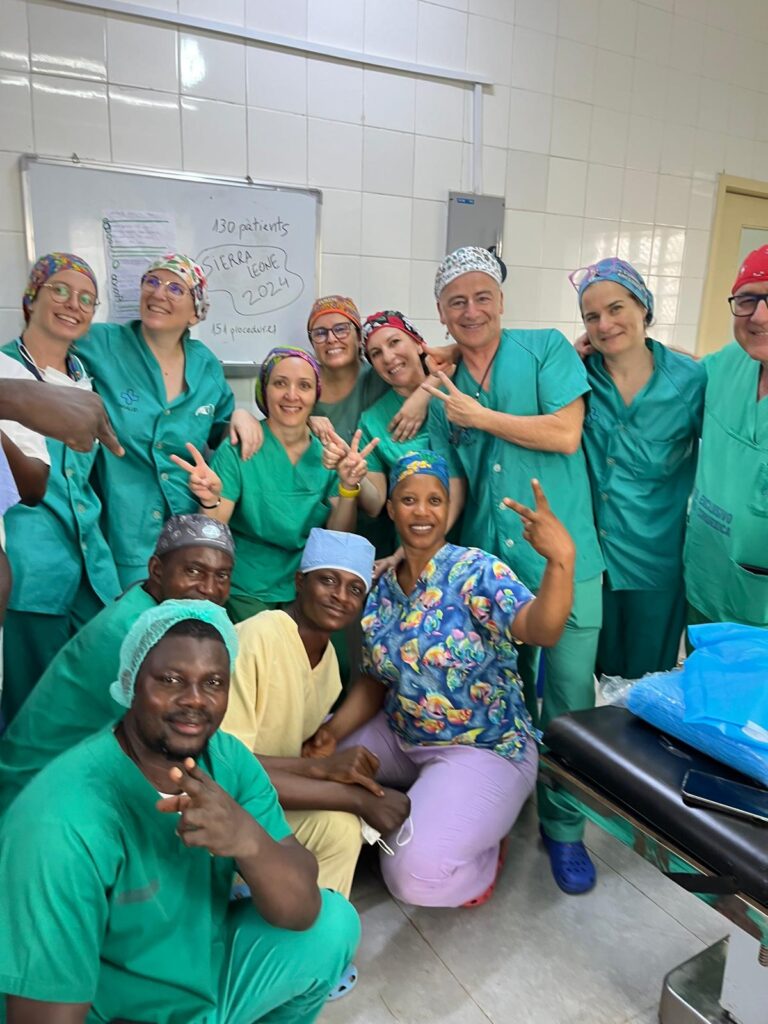
General surgeons:
Ana María Gay Fernández
Enrique Moncada Iribarren
Cristina Roque Castellanos
Paula Fernández Rodríguez
Anesthesiologist:
Miguel Ángel Pereira Loureiro
Yolanda Sanduende Otero
Nurses:
Verónica González Casal
Eva Sánchez Hernández
2.2. THE LOCAL STAFF
Dr Konteh, the hospital director, who is in charge of organising the campaign.
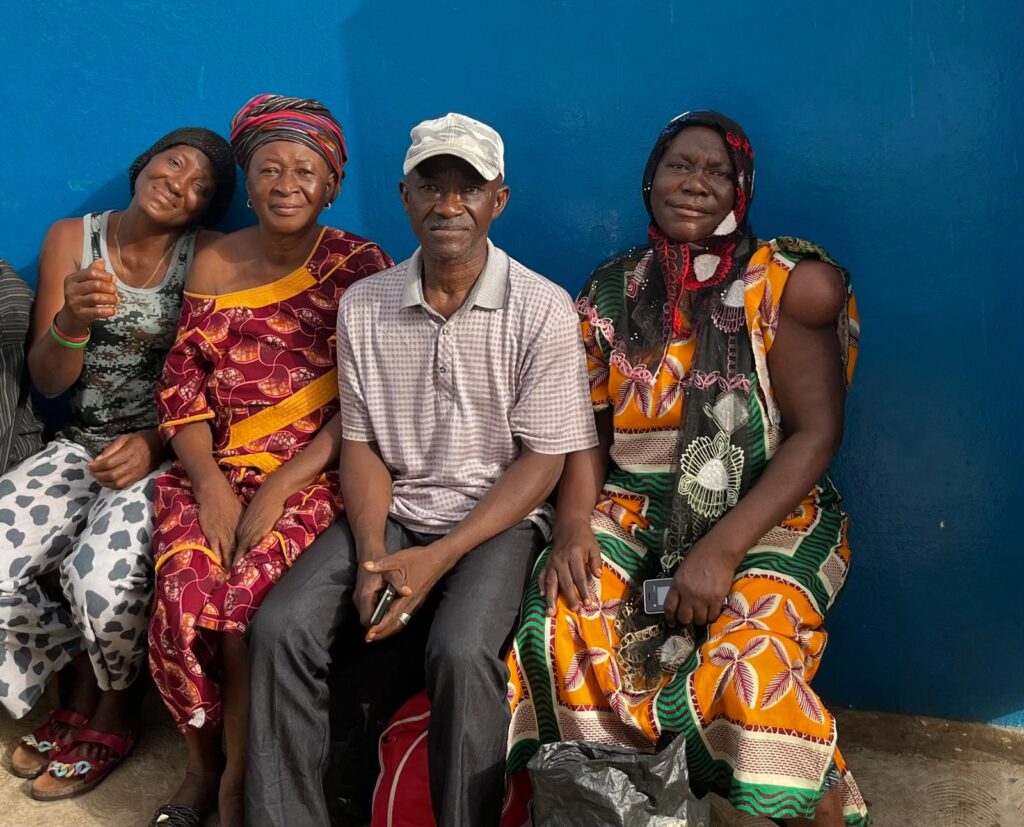
A surgical assistant (Kelly), who can help in the surgeries.
A preventivist, who is very helpful, and who helps us a lot in the operating theatre, especially in speeding up sterilisation and getting supplies when we run out.
The male nurse Francis, a hard worker, is also a great help in everything.
The nurses in the rooms are in charge of taking IVs from the patients before the operating theatre and post-operative care.
2.4 EQUIPMENT
Diathermy generators: 2. Neither of them have a plate and ours cannot be attached.
Operating theatre lamps: they have 2 lamps, which are quite deficient. One of them stopped working on the 3rd day of the campaign, and it was not possible to fix it. It is essential to carry a headlamp for the surgeries.
Consumables: sterile surgical gowns and drapes are not available. They have equipment to take peripheral lines and IV systems.
Medication: poor availability, although some things we ran out of they did get, such as antibiotics.
2.3. ANAESTHESIA

In the surgical block we had only 1 monitor that allowed us to measure O2 saturation and PANI, but it did not have electrocardiographic recording.
For this reason, we brought an automatic blood pressure monitor and a portable pulse oximeter that allowed us to have minimal monitoring on the second operating table, material that we left at the hospital in Freetown.
This double monitoring allowed us to tansfer 2 patients simultaneously to the 2 surgical tables that we placed in the same operating theatre, where we proceeded to perform spinal anaesthesia and some deep sedation, in cases of supra-umbilical pathology (some lipomas).
There were 2 oxygen concentrators that worked properly and an oxygen bullet to which we connected the ambu, but which we did not have to use at any time.
In the operating theatre there was also 1 very old aspirator.
Outside the operating theatre they had a NON-functioning Aestiva Datex-Ohmeda ventilator, so no other anaesthetic option other than local or regional, or light sedation, was ever considered. Stored in a corridor, there was another older ventilator which was also non-functional.
On arrival, the equipment available was generally scarce: some O2 goggles and ventimask, and little else.

The campaign brought from Spain all the material and medication necessary to perform intradural anaesthesia/local infiltration (lidocaine, bupi isobara and hyperbara, mepivacaine, prilocaine), sedation (propofol, ketamine, fentanyl, midazolam), as well as iv/vo antibiotics, and general emergency medication (atropines, adrenalines, amiodarone, antihistamines, corticoids in different doses, antiemetics). As for analgesics, in addition to opiates, we carried conventional IV analgesia for each operation, and oral analgesia for the first 24 hours postoperatively.
There was no stock of medicines.
As we had calculated the campaign for about 100 patients, and we exceeded expectations, we ran out of spinal needles, antibiotic prophylaxis and benzodiazepines, material and medication provided by the hospital itself, although the prophylaxis had to be done with ceftriaxone, and the needles were 24G-25G thick gauge without an introducer, which posed us greater technical difficulty on occasion.

The activity we carried out was:
| Type Anaesthesia | Type of surgery | ||
| A. Spinal | Intradurals | 110 | Hernias and infraumbilical abdominal wall |
| Sedation | Local + Sedation | 16 | Lipomas, epigastric hernias |
| Deep Sedation | 4 | large and/or deep supra-umbilical or dorsal lipomas | |
| Total | 130 | ||
Tras la intervención incluíamos analgésicos (2 AINES y opiaceo o asociacion de rescate) para las primeras 24 h del posoperatorio.
No tuvimos complicaciones importantes y entre las leves, escasa o nula hipotensión con algún episodio de náuseas/vómitos, y algún caso de analgesia insuficiente.
2.6. ASEPSIS AND SURGICAL SUPPLIES
Sterilisation: autoclave. Pressure cookers
Surgical instruments: there is material for small operations, such as hernias. There are few separators. There is no Roux type. There is also no specific material for thyroid or child surgery, so if at any time this type of surgery is considered, it will be necessary to bring material.
2.7. OUR LIFE IN FREETOWN
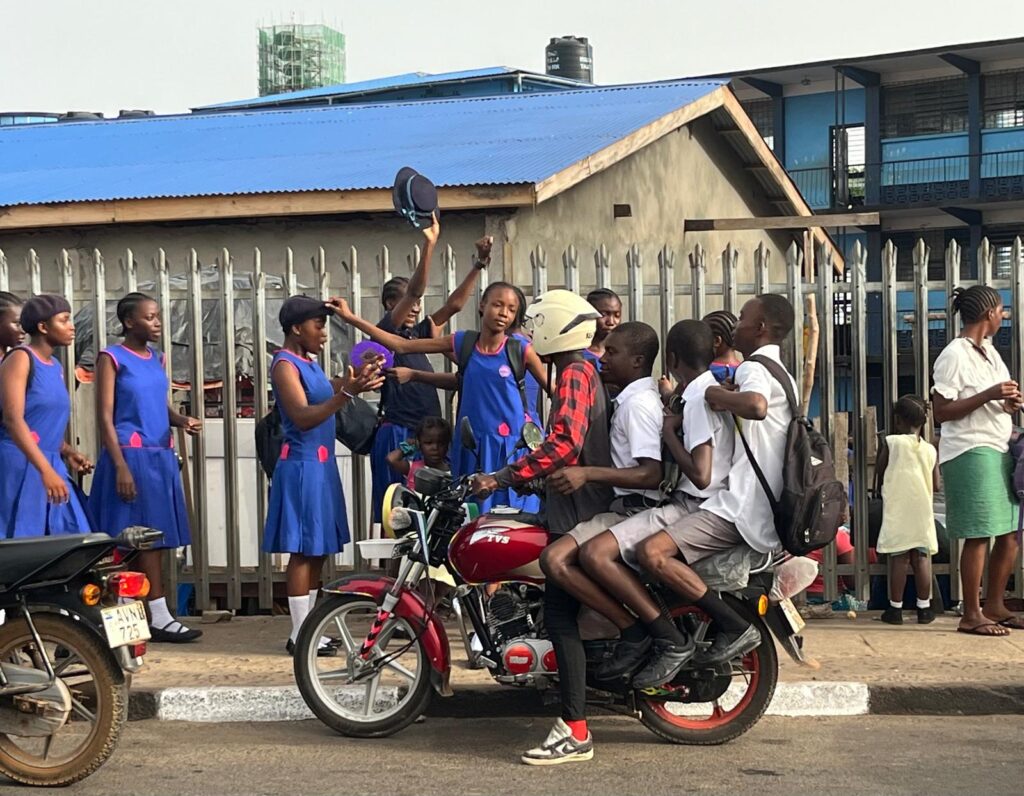
We land at Freetown airport at 2:00 a.m. Dr Konteh, director of the hopistal and organiser of the campaign, is waiting for us there with Abu, a security policeman who accompanies us to the hospital every day. We collect our luggage and pass through customs without incident thanks to Dr Konteh’s help. Then we go to catch the bus (about 15 minutes), which takes us to the ferry, which takes about 45 minutes. We arrive at the hotel at about 5am. After a few hours rest we head to the hospital. While the nursing and anaesthesia team open the material packs and get everything ready for the surgeries, the surgical team is ready to see the potential surgical patients. Patient recruitment was extensive. On arrival we had more than 300 surgical candidates. However, no one had done a screening, so we saw many non-surgical pathologies, or pathologies that could not be operated on in a campaign where general anaesthesia is not possible. Finally, after many hours of seeing patients and after recruiting 145 patients for surgery, we decided not to continue with the screening, so that we could start operating that same day, late in the afternoon, almost at night. We scheduled the surgeries for later days.
The day after our arrival we were received by the Chief Inspector of Police (Mr. William Fayia Sellu), in a brief ceremony held at the police headquarters, and he gave us our permits to work in the country.
Thus began a very hard campaign, with intense heat during the day and night, working daily from 8 in the morning, extending most days until more than 9 at night, since an average of 25 patients were operated on per day. In the end, despite having two operating theatres, we decided to use only one, with two tables, to speed up the work.
We started the day with breakfast at the hotel. They provide coffee, powdered milk, juice and you can order omelettes and pancakes. At 8 a.m. we are picked up by Dr Konteh with Abu, a 15-minute drive to the hospital.
On arrival, while the first patients are being anaesthetised and everything is getting underway, the surgeons visit the patients from the previous day, so that they can be discharged and make room for the patients who will be operated on that day.
We make a short stop for lunch. Pizza, chicken, pasta and a few other things can be ordered from a nearby restaurant. The local staff bring them every day, although you have to order well in advance, so on many days we just ordered bread and fruit and added cold meats that we had brought in our suitcases.
In the evening we dine at the hotel, having ordered our orders in the morning before we left. The offer is similar to that of the lunch restaurant: rice, pizza, chicken or pasta.
On the 4th day of the camp, the connection of the scalpel plate they have in the hospital broke, and it was not possible to fix it, so we were left with only one scalpel. We decided to continue on 2 tables, exchanging the scalpel that we had brought with us, as one surgery was finished, we started on the next table, with everything already prepared. This, of course, delayed us a lot, and it was impossible for us to keep to the schedule, which was already complicated to carry out. Therefore, we prioritised patients with hernias and suspended several lipomas that do not pose any risk and can be operated on in successive campaigns.
Finally on the last day they got another generator that worked properly and we operated on the remaining 11 patients, somewhat simpler hernias than in the previous days, to avoid complications. After finishing all the work, we collected and packed the diathermy generator and some more material to take back to Spain.
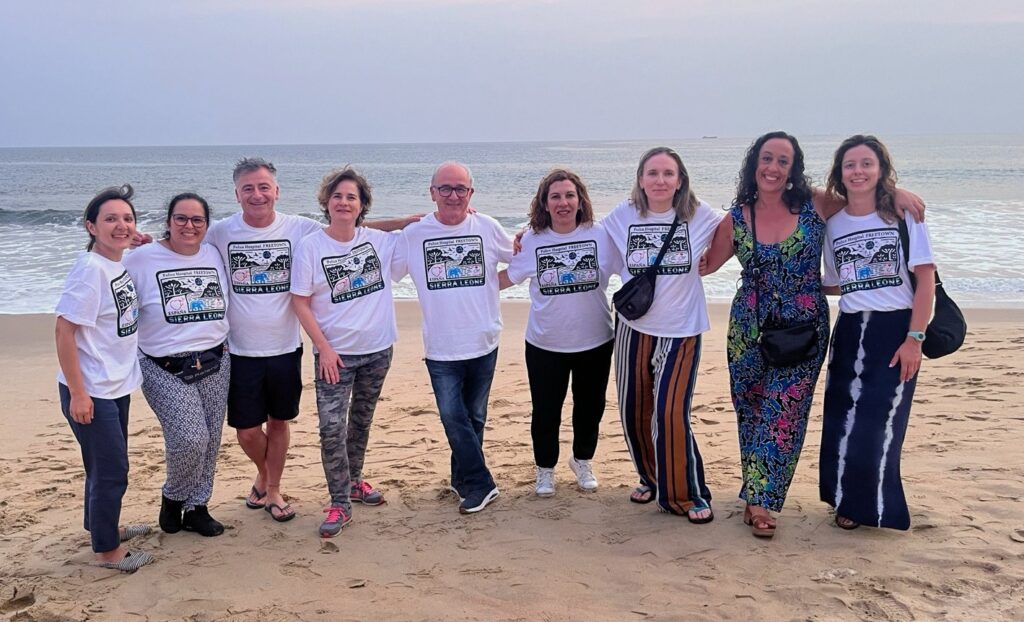
After resting for a while at the hotel (they let us stay in the rooms until the afternoon), Dr. Konteh and Abu picked us up to take us to the beach area, where they had prepared a farewell dinner for us. Beforehand, we met up at the hotel with my colleague and friend, Dr Marta Lado, an internist working in Sierra Leone, with whom it was impossible to meet for the rest of our stay, as our working days were too long. I met Dr Lado almost 20 years ago when we were both training in Spain. Her eagerness to train in infectious diseases took her to Sierra Leone 10 years ago. She came for a few months, but stayed during the Ebola outbreak at the time, and the country and its people got to her. She works with an American NGO (Partners in Health), carrying out health plans, as well as participating in the WHO’s outbreak emergencies group. By coincidence, Dr Lado was Dr Konteh’s mentor, so she is also joining us for the farewell dinner. It is a great pleasure and honour to have her and her knowledge of medicine and the country we are in. She can certainly be a support in future missions if needed.
During dinner, we are given gifts: a police T-shirt and a notebook with our name engraved on it. After dinner they play music and we dance until it is time to leave for the airport.
Dr Konteh accompanies us there, and thanks to his contacts, we avoid paying the departure tax, which is about 100 euros per person.
The return journey is uneventful until we arrive in Madrid, where we realise that one of the checked-in bags has not arrived. We recover it in Vigo that same week.
And now back, with the satisfaction of a job well done, we bid farewell until the next one. This mission has been particularly hard at times, with many hours of work, more than expected, with a lack of means and material, as well as a lot of heat. But as always happens in this type of campaign, the team spirit and mutual support, makes us draw strength from nowhere, to continue and that everything runs smoothly. Thanks to all the team, for the effort and the desire, and above all for coming back for another year…
- CONCLUSION
3.1 Strengths of this place:
Sierra Leone is a country with a very poor health system. There are few doctors, and especially few surgeons and almost no anaesthetists. As a result, there is a huge number of patients, adults and children, who are potentially surgical. The Police Hospital, despite its shortcomings, is prepared for such campaigns. Dr Konteh is able to organise the campaigns and solve problems as they arise. The hospital staff is well adapted to the work, improving as the campaign progresses.
3.2. Improvement objectives:
– Prior screening of patients is essential. To rule out non-surgical pathologies and inoperable surgical pathologies during the campaign. It is very difficult to see such a large number of patients in such a short time, and above all, it is a significant waste of time, as more than half of the patients we screened in this campaign had no surgical pathology, or were not susceptible to surgery during the campaign due to the type of pathology.
– Improve pre- and post-operative care: in future campaigns it would be interesting to have nursing staff who can instruct local staff in this care: post-operative analgesia, wound care, correct channelling of IVs, taking of vital signs, etc., especially if the aim is to operate on more complex pathologies, as the knowledge of local nursing staff is very limited.
– Obtain a respirator that works properly.
– In future campaigns, if a respirator and a monitor can be obtained, three simultaneous operating tables could be set up.
4. BUDGET:
4.1. COST PER PARTICIPANT:
Participants travelling from Vigo, single room hotel: 2.021,10
Participants from Vigo, double room: 1.839,25
Participant from Gran Canaria, single room: 2.009,26
4.2. TOTAL COST OF THE CAMPAIGN:
Flight tickets Vigo/Gran Canaria-Freetown round trip: 10.654,08
Visas: 640 euros
Hotel: 2 double rooms, 4 single rooms, 6 nights: 2.635,48 euros
Meals: 500 euros
Ferry: 1000 euros
TOTAL COST OF THE CAMPAIGN: 15.429,56
5. SIGNATURES
Signed: Ana Gay
Responsible for the campaign
Surgeons in Action
